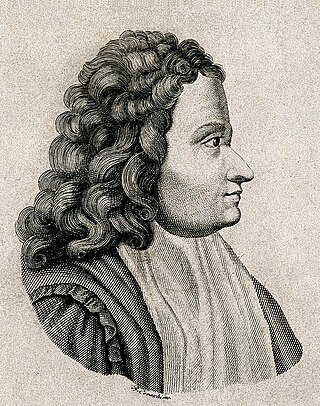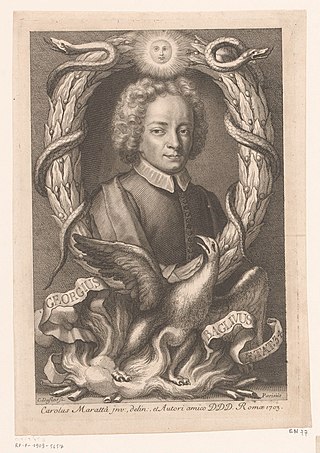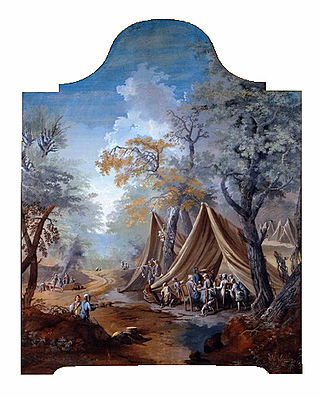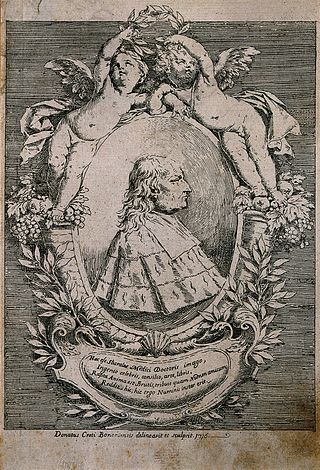Related Research Articles

Marcello Malpighi was an Italian biologist and physician, who is referred to as the "Founder of microscopical anatomy, histology & Father of physiology and embryology". Malpighi's name is borne by several physiological features related to the biological excretory system, such as the Malpighian corpuscles and Malpighian pyramids of the kidneys and the Malpighian tubule system of insects. The splenic lymphoid nodules are often called the "Malpighian bodies of the spleen" or Malpighian corpuscles. The botanical family Malpighiaceae is also named after him. He was the first person to see capillaries in animals, and he discovered the link between arteries and veins that had eluded William Harvey. Malpighi was one of the earliest people to observe red blood cells under a microscope, after Jan Swammerdam. His treatise De polypo cordis (1666) was important for understanding blood composition, as well as how blood clots. In it, Malpighi described how the form of a blood clot differed in the right against the left sides of the heart.

Luigi Galvani was an Italian physician, physicist, biologist and philosopher, who studied animal electricity. In 1780, he discovered that the muscles of dead frogs' legs twitched when struck by an electrical spark. This was an early study of bioelectricity, following experiments by John Walsh and Hugh Williamson.

The University of Bologna is a public research university in Bologna, Italy. Founded in 1088 by an organised guild of students (studiorum), it is the oldest university in continuous operation in the world, and the first degree-awarding institution of higher learning. At its foundation, the word universitas was first coined. The university's emblem carries the motto, Alma Mater Studiorum, the date A.D. 1088. With over 90,000 students, the University of Bologna is one of the largest universities in Europe.

Giovanni Alfonso Borelli was a Renaissance Italian physiologist, physicist, and mathematician who is often described as the father of biomechanics. He contributed to the modern principle of scientific investigation by continuing Galileo's practice of testing hypotheses against observation. Trained in mathematics, Borelli also made extensive studies of Jupiter's moons, the mechanics of animal locomotion and, in microscopy, of the constituents of blood. He also used microscopy to investigate the stomatal movement of plants, and undertook studies in medicine and geology. During his career, he enjoyed the patronage of Queen Christina of Sweden. He was the first scientist to explain that animal and human bodily movements are caused by muscular contractions.

Antonio Maria Valsalva, was an Italian anatomist born in Imola. His research focused on the anatomy of the ears. He coined the term Eustachian tube and he described the aortic sinuses of Valsalva in his writings, published posthumously in 1740. His name is associated with the Valsalva antrum of the ear and the Valsalva maneuver, which is used as a test of circulatory function. Anatomical structures bearing his name are Valsalva’s muscle and taeniae Valsalvae. He observed that when weakness of one side of the body is caused by a lesion in the brain, the culprit lesion tends to be on the side opposite (contralateral) to the weak side; this finding is named the "Valsalva doctrine" in his honor.

Antonio Pacchioni was an Italian scientist and anatomist, who focused chiefly on the outermost meningeal layer of the brain, the dura mater.

Laura Maria Caterina Bassi Veratti was an Italian physicist and academic. Recognized and depicted as "Minerva", she was the first woman to have a doctorate in science, and the second woman in the world to earn the Doctor of Philosophy degree. Working at the University of Bologna, she was the first salaried female teacher in a university. At one time the highest paid employee of the university, by the end of her life Bassi held two other professorships. She was also the first female member of any scientific establishment, when she was elected to the Academy of Sciences of the Institute of Bologna in 1732 at 21.

Giorgio Baglivi, born Giorgio Armeno and sometimes anglicized as George Baglivi, was a Croatian-Italian physician and scientist. He made important contributions to clinical education, based on his own medical practice. His De Fibra Motrice advanced the "solidist" theory that the solid parts of organs are more crucial to their good functioning than their fluids, against the traditional belief in four humors. Baglivi, however, advocated against doctors relying on any general theory rather than careful observation. He was "a distinguished physiological researcher fascinated by the nerves, his microscopic studies enabled him to distinguish between smooth and striated muscles and distinct kinds of fibres."

Agostino Scilla was an Italian Baroque painter, paleontologist, geologist, numismatist, and a pioneer in the study of fossils and in scientific illustration. In addition to his paintings, he published an early text on paleontology: La vana speculazione disingannata dal senso which was introduced to English audiences by William Wotton of the Royal Society in 1696. He was among the first to promote a scientific understanding of fossils in contrast to fantastic Biblical and divine interpretations.
Oliger Jacobaeus (1650-1701), also known as Holger Jacobi, was a Danish physician and naturalist. He was professor of medicine, philosophy, history, and geography at University of Copenhagen.

Carlo Lodi was an Italian painter of the late-Baroque period in Bologna, mainly painting landscapes.

The Academy of Sciences of the Institute of Bologna is an academic society in Bologna, Italy, that was founded in 1690 and prospered in the Age of Enlightenment. Today it is closely associated with the University of Bologna.

Pietro Albertoni was an Italian physiologist and politician who was appointed Senator of the Kingdom in 1912.

Philipp Friedrich Theodor Meckel was a German anatomist, surgeon and obstetrician.

Ovidio Montalbani, also known by his pseudonym Giovanni Antonio Bumaldi, was an Italian polymath. He was a professor of logic, mathematics, astronomy, and medicine at the University of Bologna.
Vincenzo Antonio Menghini was an Italian physician and scientist, who was one of the first to report the abundance of iron in red blood cells.

Giovanni Girolamo Sbaraglia was an Italian physician and writer. He was a determined, perhaps obsessed, critic of the famous anatomist Marcello Malpighi.

Giovanni Tumiati was a physician and anatomist, active mainly in his native Ferrara.
Bartolomeo Massari was an Italian painter turned astrological doctor and anatomist. He was the tutor of Marcello Malphigi and Carlo Fracassati.
References
- ↑ Dizionario biografico universale, Volume 5, by Felice Scifoni, Publisher Davide Passagli, Florence (1849); page 649.
- ↑ Giovanni Giacinto Vogli, il medico budriese studiato dal Galvani, article by Leonardo Arrighi in BudrioNext, 12 November 2015.